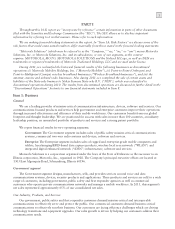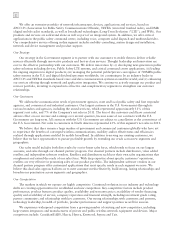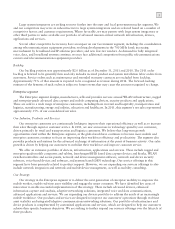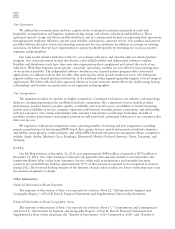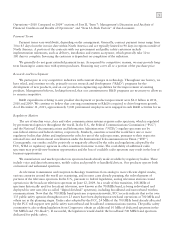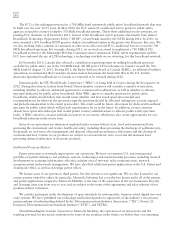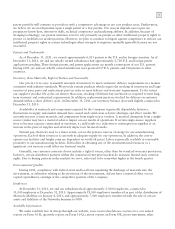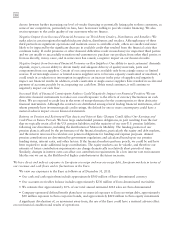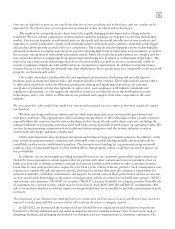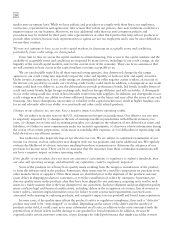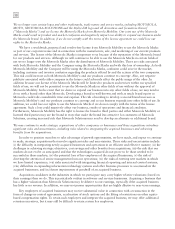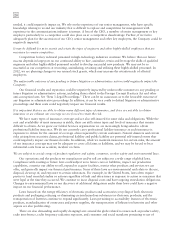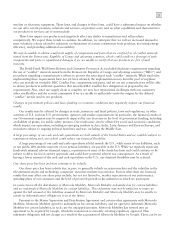Motorola 2011 Annual Report Download - page 17
Download and view the complete annual report
Please find page 17 of the 2011 Motorola annual report below. You can navigate through the pages in the report by either clicking on the pages listed below, or by using the keyword search tool below to find specific information within the annual report.
11
Our success depends in part on our timely introduction of new products and technologies and our results can be
impacted by the effectiveness of our significant investments in new products and technologies.
The markets for our products are characterized by rapidly changing technologies and evolving industry
standards. We face intense competition in these markets and new products are expensive to develop and bring to
market. Our success depends, in substantial part, on the timely and successful introduction of new products and
upgrades of current products to comply with emerging industry standards and to address competing technological
and product developments carried out by our competitors. The research and development of new, technologically-
advanced products is a complex and uncertain process requiring high levels of innovation and investment, as well as
the accurate anticipation of technology and market trends. Many of our products and systems are complex and we
may experience delays in completing development and introducing new products or technologies in the future. We
may focus our resources on technologies that do not become widely accepted or are not commercially viable or
involve compliance obligations with additional areas of regulatory requirements. In addition, our products may
contain defects or errors that are detected only after deployment. If our products are not competitive or do not work
properly, our business will suffer.
Our results are subject to risks related to our significant investment in developing and introducing new
products, such as integrated digital radios and integrated public safety systems. These risks include among others:
(i) difficulties and delays in the development, production, testing and marketing of products; (ii) customer
acceptance of products; (iii) the development of, approval of, and compliance with industry standards and
regulatory requirements; (iv) the significant amount of resources we must devote to the development of new
technologies; and (v) the ability to differentiate our products and compete with other companies in the same
markets.
We are exposed to risks under large multi-year system and managed services contracts that may negatively impact
our business.
We enter into large multi-year system contracts with large municipal, state, nation-wide government and
enterprise customers. This exposes us to risks, including among others: (i) the technological risks of such contracts,
especially when the contracts involve new technology, and (ii) financial risks under these contracts, including the
estimates inherent in projecting costs associated with large contracts and the related impact on operating results. We
are also facing increasing competition from traditional system integrators and the defense industry as system
contracts become larger and more complicated.
Political developments also can impact the nature and timing of large government contracts. In addition, multi-
year awards from governmental customers may often only receive partial funding initially and may typically be
cancellable on short notice with limited penalties. The termination of funding for a government program would
result in a loss of anticipated future revenue attributable to that program, which could have an adverse impact on
our profitability.
In addition, we are increasingly providing managed services to our customers, particularly as we expand our
Global Services organization, which requires that we partner with other systems and services providers, often on
multi-year projects, to design, construct, manage and operate a public-safety system or other commercial system.
From time to time such projects may require that we form a joint venture with our partners. Such arrangements may
require us to assume the risk and agree to specific performance metrics that meet the customer’s requirement for
network availability, reliability, maintenance and support. In certain cases, if these performance metrics are not met
we may not be paid. Depending on the nature of such projects, which are referred to as build-own-operate (“BOO”)
and in some cases maintain (“BOOM”) or transfer (“BOOT”), we may be unable to recognize revenue from the sale
of equipment for a period of time, which may be several years. Such BOO, BOOM and BOOT arrangements shift
risk to us and may result in an adverse impact on our profitability if we are unable to meet the requirements of such
contracts.
The expansion of our business into managed services creates new and increased areas of risk that we have not been
exposed to in the past and that we may not be able to properly assess or mitigate against.
In July 2011, we announced the formation of our Global Services organization and we plan to expand our
business by offering additional and expanded managed services for existing and new types of customers, such as
designing, building and managing the network for emergency service organizations or enterprise customers. The


